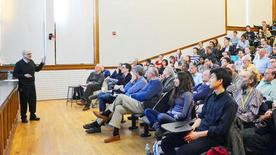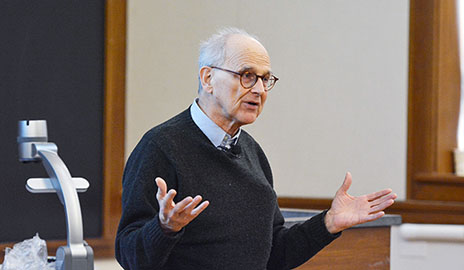
Perhaps it was fitting that Rainer Weiss visited Yale on Leap Day to talk about the groundbreaking detection of gravitational waves and the decades of work that led up to it.
Just a few weeks ago, scientists announced that Albert Einstein’s 1916 prediction of gravitational waves finally had been proven. With that announcement, science seemed to vault several steps forward, advancing the world’s knowledge and opening possibilities for research in multiple disciplines. And at the center of it all was Weiss, the MIT physicist who set the LIGO experiment in motion back in the late 1960s.
“Something wonderful and magnificent has happened, which is why we are all here,” said Charles Baltay, Yale’s Eugene Higgins Professor of Physics and Astronomy, in introducing Weiss to a standing-room-only crowd at Sloane Physics Laboratory on Feb. 29. Baltay noted that while “hundreds of dedicated scientists” were involved in the work, Weiss was the person who shepherded the LIGO experiment from its inception.
On Feb. 11, the Advanced Laser Interferometer Gravitational-Wave Observatory (Advanced LIGO) team announced that it had detected a “chirp” emitted by gravitational waves created from the merging of two black holes in a distant part of the universe. Gravitational waves are ripples in the fabric of space and time, constantly pushing and pulling as they travel. Scientists say the findings are likely to have far-reaching implications for studying the universe.
In his talk at Yale, Weiss gave a sweeping overview of the search for gravitational waves, from Einstein’s theory of general relativity to LIGO. He credited dozens of key researchers whose work — including their mistakes, sometimes — contributed to the investigation in some way.
 Even Einstein himself didn’t get everything right, Weiss explained. For example, Einstein speculated at one point that the effects of gravitational waves would not be dramatic.
Even Einstein himself didn’t get everything right, Weiss explained. For example, Einstein speculated at one point that the effects of gravitational waves would not be dramatic.
Weiss enthusiastically continued the timeline: the groundbreaking black hole research in the 1930s, initial attempts to build a gravitational wave detector in the 1960s, and work in the 1970s and 1980s in America and Europe to refine interferometer technology, bit by bit.
Weiss detailed some of the technical challenges, such as reducing seismic noise, and the prospects of someday putting gravitational wave detectors in space. He explained that the two American-based detectors currently in use (in Louisiana and Washington state) will be joined by three other detectors located around the globe.
And then Weiss focused on the chirp that LIGO heard. It was a “huge” signal, he said; it was a “monster” signal.
“We had never seen anything like this from the apparatus,” he said, the excitement evident in his voice. “It looked too good to all of us.” In fact, he noted, the team spent a good deal of time taking extra steps to be sure no one had hacked the experiment.
Once they were certain the signal was good, the LIGO team — and the rest of the scientific community — could look to the work that will follow. Weiss said scientists will search for more gravitational waves; they will try to pinpoint the waves’ origin point; and they will use findings to learn more about supernovae, pulsars, gamma ray bursts, and black holes.
Baltay said Yale will be involved in investigating whether gravitational wave signals also emit optical radiation.
As Weiss explained, the discovery opens a window “to look for new things in the universe we couldn’t see before.”